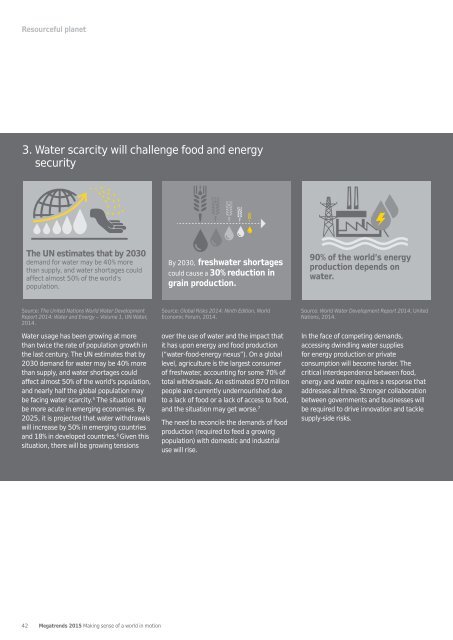ey-megatrends-report-2015
ey-megatrends-report-2015
ey-megatrends-report-2015
Create successful ePaper yourself
Turn your PDF publications into a flip-book with our unique Google optimized e-Paper software.
Resourceful planet<br />
3. Water scarcity will challenge food and energy<br />
security<br />
The UN estimates that by 2030<br />
demand for water may be 40% more<br />
than supply, and water shortages could<br />
affect almost 50% of the world's<br />
population.<br />
By 2030, freshwater shortages<br />
could cause a 30% reduction in<br />
grain production.<br />
90% of the world’s energy<br />
production depends on<br />
water.<br />
Source: The United Nations World Water Development<br />
Report 2014: Water and Energy — Volume 1, UN Water,<br />
2014.<br />
Water usage has been growing at more<br />
than twice the rate of population growth in<br />
the last century. The UN estimates that by<br />
2030 demand for water may be 40% more<br />
than supply, and water shortages could<br />
affect almost 50% of the world's population,<br />
and nearly half the global population may<br />
be facing water scarcity. 5 The situation will<br />
be more acute in emerging economies. By<br />
2025, it is projected that water withdrawals<br />
will increase by 50% in emerging countries<br />
and 18% in developed countries. 6 Given this<br />
situation, there will be growing tensions<br />
Source: Global Risks 2014: Ninth Edition, World<br />
Economic Forum, 2014.<br />
over the use of water and the impact that<br />
it has upon energy and food production<br />
(“water-food-energy nexus”). On a global<br />
level, agriculture is the largest consumer<br />
of freshwater, accounting for some 70% of<br />
total withdrawals. An estimated 870 million<br />
people are currently undernourished due<br />
to a lack of food or a lack of access to food,<br />
and the situation may get worse. 7<br />
The need to reconcile the demands of food<br />
production (required to feed a growing<br />
population) with domestic and industrial<br />
use will rise.<br />
Source: World Water Development Report 2014, United<br />
Nations, 2014.<br />
In the face of competing demands,<br />
accessing dwindling water supplies<br />
for energy production or private<br />
consumption will become harder. The<br />
critical interdependence between food,<br />
energy and water requires a response that<br />
addresses all three. Stronger collaboration<br />
between governments and businesses will<br />
be required to drive innovation and tackle<br />
supply-side risks.<br />
42 Megatrends <strong>2015</strong> Making sense of a world in motion


